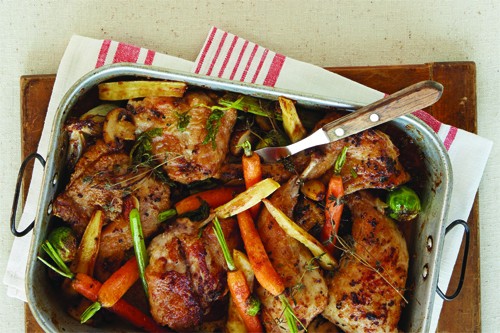
Rabbit meat is high in protein and low in total fat. Compared to roasted chicken (skin removed), a 3½-ounce portion of roasted domesticated rabbit provides more iron (2.27mg in rabbit vs. 1.21mg in chicken), more selenium (38.5mcg vs. 22mcg) and about half the sodium (47mg vs. 86mg). Rabbit meat also provides 320mg of omega-3 fatty acids — more than four times the amount found in chicken.
Rabbit meat can be ordered online or sourced through local farmers or butchers, but because production is relatively small-scale, its price per pound can be expensive. However, anti-hunger initiatives — such as Heifer International and Partners of the Americas Farmer to Farmer program — lead backyard farming lessons in sustainability and frugality that include raising rabbits. Starting with one buck (male rabbit) and one doe (female rabbit), a family can produce the same amount of meat in one year as an entire cow.
While most shoppers purchase individual cuts of meat and poultry pieces instead of a whole animal, rabbits are generally sold in their entirety. Whole-animal cooking can mean less waste — using the leftover carcass to make stock, for example — and when it comes to rabbit meat, low and slow is the way to go. Because the meat is so lean, it will quickly become dry if overcooked.
Jon Godar, who raises rabbits on Eli Creek Farm in Connersville, Ind., says his favorite recipe is wonderfully simple. “Place a whole rabbit and some chopped celery in your slow cooker,” he says. “Cover with water and cook on low for 13 hours. Remove the meat from the bones and serve over egg noodles.”
Clean and quiet, rabbits are an easy choice for rural and urban homesteaders. To aid in processing manure, some breeders install a worm composter under cages. Available resources to help the rabbit breeder include Storey’s Guide to Raising Rabbits, 4 Ed. (Storey Publishing 2009) and the American Rabbit Breeders Association. Since slaughter and processing regulations vary, check with local authorities to ensure compliance. Finally, remember that the very qualities that make rabbits a sustainable food source also make them an environmental pest, so always raise rabbits responsibly and never release them into the wild.
Local 127 Braised Rabbit
Developed by Steven Geddes
Serves 4
Ingredients
1 whole rabbit, 21/2 to 31/2 pounds, cut into pieces
1/2 cup flour
1⁄4 cup cornstarch
1 teaspoon smoked paprika
Salt and pepper to taste
2 tablespoons olive oil
4 cups diced* aromatic vegetables (such as carrots, onions, celery, garlic or parsnips)
1/2 cup dry white wine
2 cups vegetable stock
Instructions
- Preheat oven to 200°F. Place a Dutch oven or cast iron skillet on your stovetop and preheat over medium-high heat. Add olive oil.
- In a pie plate or shallow bowl, mix flour, cornstarch, smoked paprika, salt and pepper. Dredge the rabbit pieces in mixture to coat. Discard excess flour mixture.
- Brown the pieces of rabbit in the pan (avoid crowding), then remove rabbit from the pan and set aside. Add aromatic vegetables to the pan and sauté for 2 to 3 minutes. Add wine and stock to deglaze the pan and stir.
- Place rabbit back into the pan. Cover and bake in the oven for 2 to 3 hours or until meat is very tender.
*For firmer vegetables, add them about halfway through baking or cut in larger pieces.
Nutritional Info
6 ounces of rabbit and 1 cup vegetables
Calories: 493
Total fat: 20g; Sat. fat: 5g
Chol.: 126mg; Sodium: 347mg
Carb.: 29g; Fiber: 5g; Sugars: 8g
Protein: 48g; Potassium: N/A; Phosphorus: N/A

